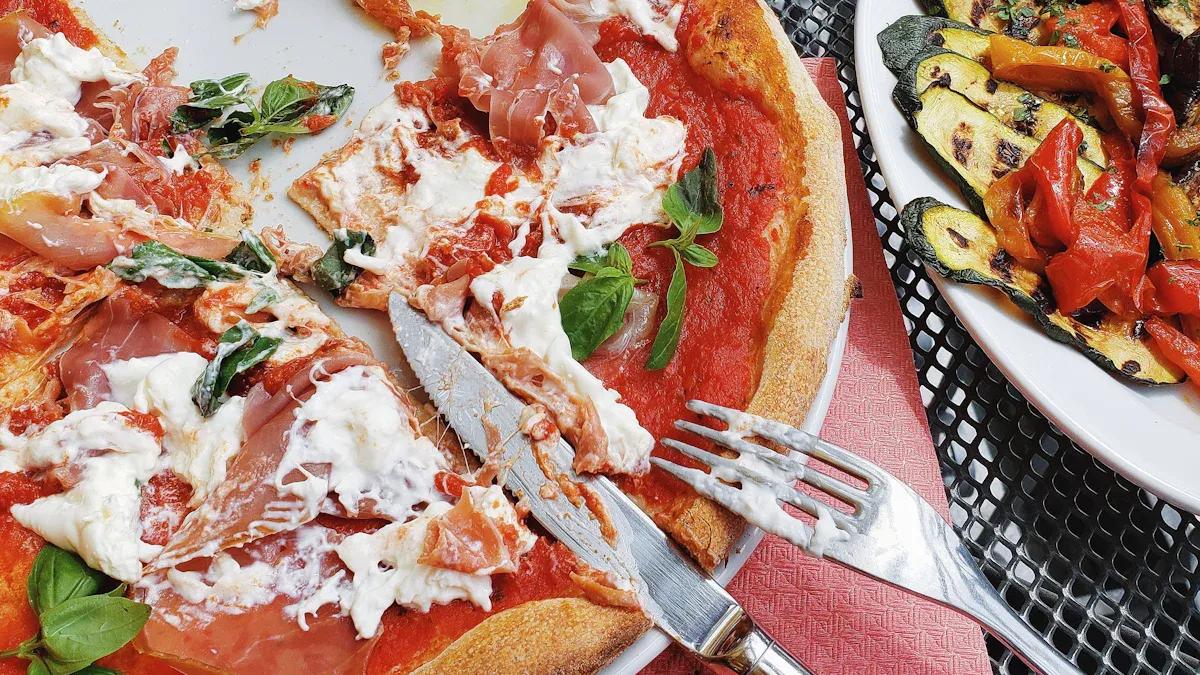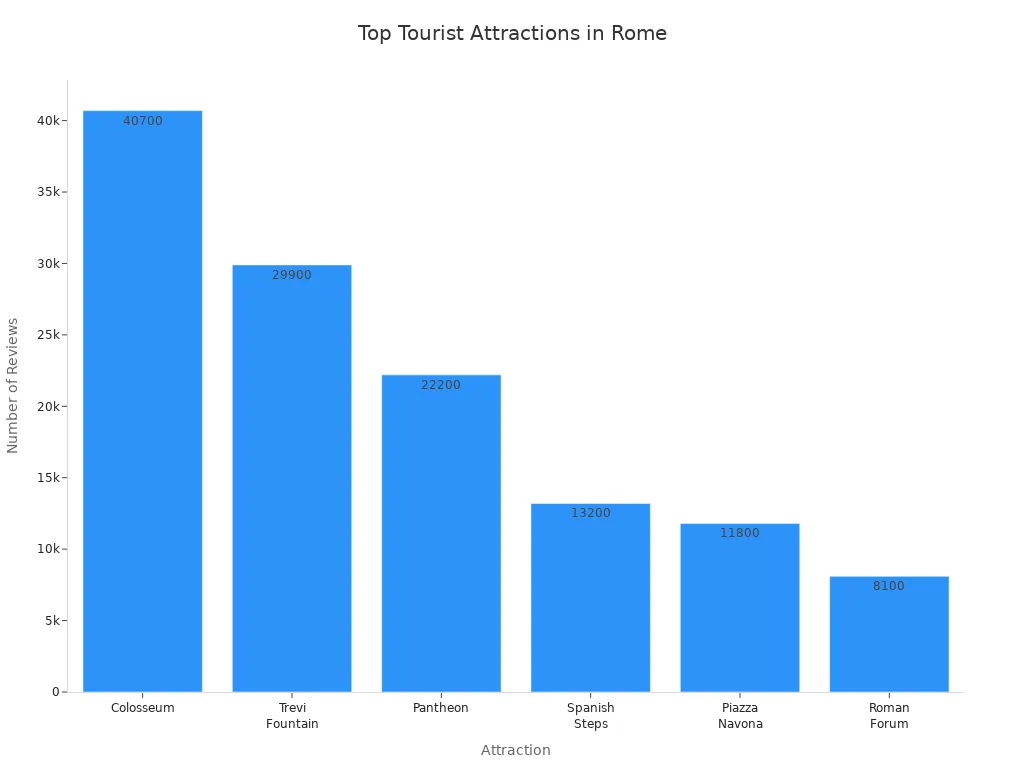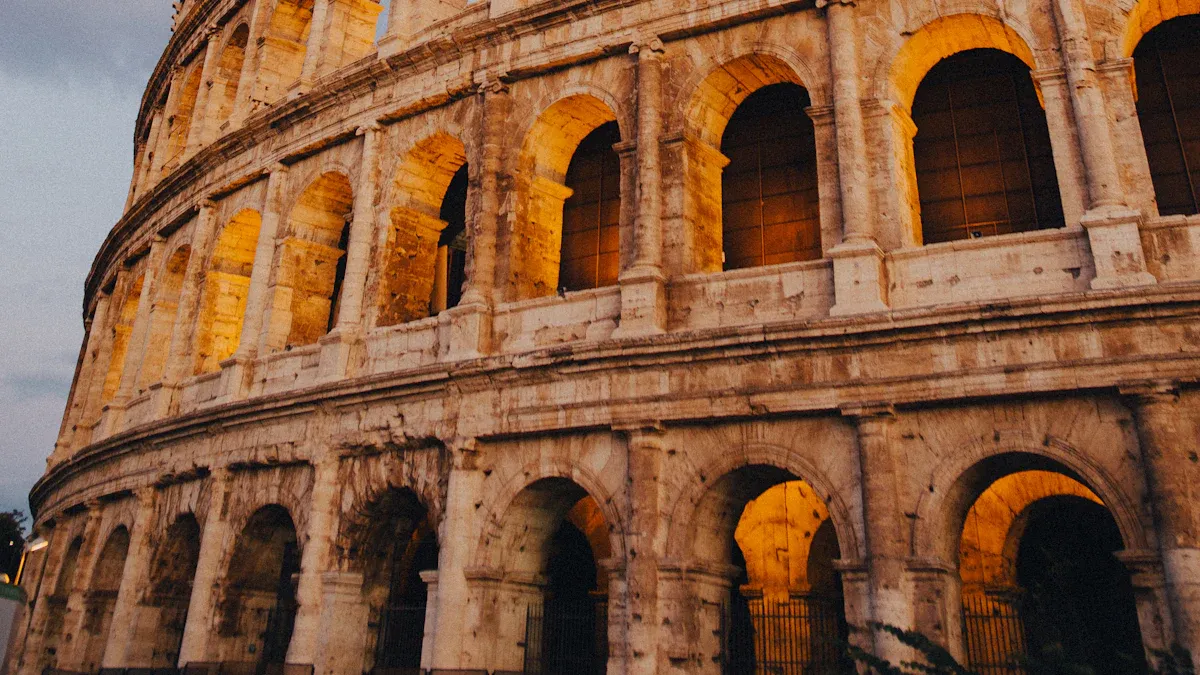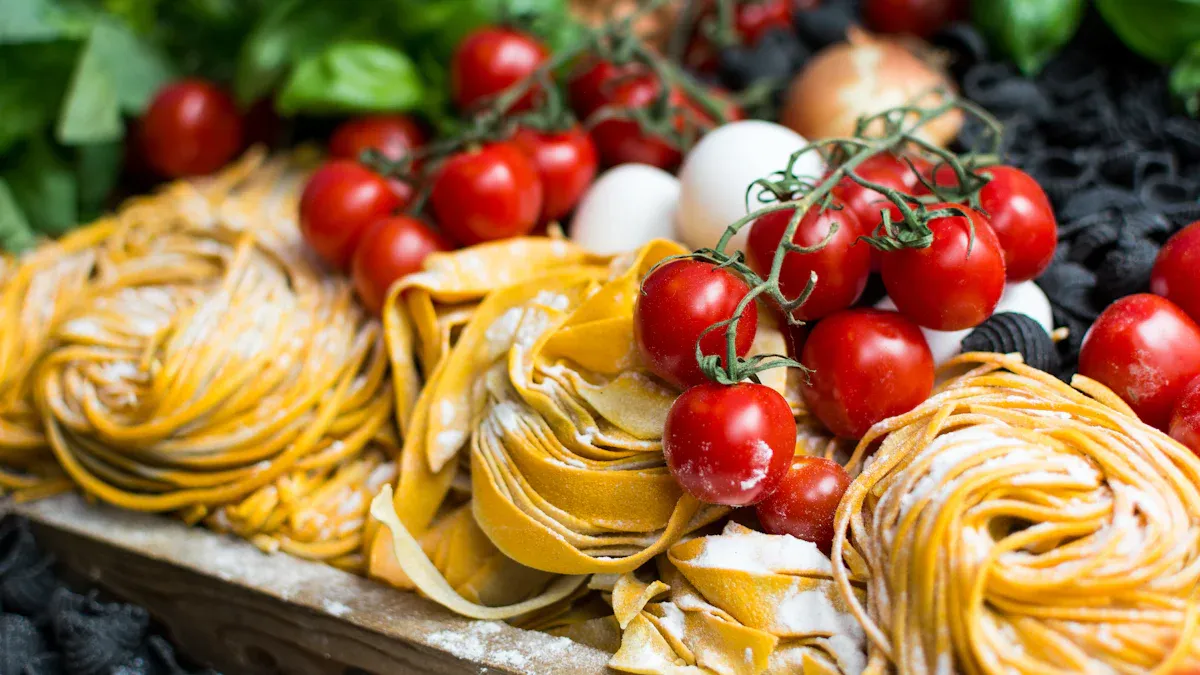
You step into Rome and instantly feel the energy of ancient streets, bustling piazzas, and living history. Rome draws 7-10 million visitors every year, all hoping to experience its unique mix of art, food, and culture. The city’s heart beats with Italian culture at every corner, from the aroma of espresso to the laughter echoing through trattorias. Dive into the local rhythm—visit the Must-See Sights, taste authentic Roman pasta, and learn a few key customs to blend in. Rome’s culture invites you to slow down, savor every meal, and embrace Italian culture with open arms. These moments will help you understand why Rome is the second most visited city in Europe. Check out the most visited attractions below:
Rank | Attraction | Reviews |
|---|---|---|
1 | Colosseum | 40.7k |
2 | Trevi Fountain | 29.9k |
3 | Pantheon | 22.2k |
4 | Spanish Steps | 13.2k |
5 | Piazza Navona | 11.8k |
6 | Roman Forum | 8.1k |

Key Takeaways
Visit the Colosseum and Roman Forum to experience the heart of ancient Rome. These iconic sites tell the story of the city’s rich history.
Explore the Vatican Museums and St. Peter’s Basilica for a glimpse of world-class art and architecture. Booking tickets online saves time and avoids long waits.
Savor authentic Roman pasta dishes like Cacio e Pepe and Carbonara at local restaurants. Enjoying these meals is a must for any food lover.
Wander through Rome’s historic neighborhoods like Monti and Trastevere to discover local life and hidden gems. Each area offers unique experiences and flavors.
Use public transportation to navigate the city easily. The metro and buses are affordable and eco-friendly options for getting around.
Must-See Sights in Rome

Rome is a city where every street feels like a museum. You can find history, art, and culture around every corner. If you want to experience the best of Rome, you need to visit its must-see sights. These attractions are famous for a reason. They tell the story of Rome’s past and show you why millions of people fall in love with this city every year.
Colosseum & Roman Forum
You cannot visit Rome without seeing the Colosseum. This ancient arena stands as a symbol of the city. The Colosseum attracts more than six million visitors every year. When you walk inside, you can almost hear the roar of the crowds from gladiator games. The Colosseum and Roman Forum sit next to each other, forming the heart of ancient Rome.
The Roman Forum was the center of daily life for over a thousand years. Here’s what made it special:
The Forum served as the civic, commercial, political, and religious center of ancient Rome.
It grew from a swampy valley into a busy marketplace and political arena.
Important buildings like temples, basilicas, and the Senate house stood here.
The Forum hosted triumphal processions, elections, public speeches, and even gladiatorial matches.
Statues and monuments honored Rome’s leaders.
The Forum was the most celebrated meeting place in history, with many temples later turned into churches.
Today, the remains show its former glory and attract over 4.5 million visitors each year.
You should buy tickets from the official sites to avoid long lines and scams. Many travelers also enjoy Vespa tours around the Colosseum and Forum. These tours let you see the sights like a local and feel the wind in your hair.
Vatican Museums & St. Peter’s
The Vatican Museums are a treasure chest of art. You will find masterpieces like the Sistine Chapel, the Raphael Rooms, and works in the Pinacoteca. The museums display about 20,000 pieces, including ancient sculptures, Renaissance paintings, and modern art. The collection shows the power of the Church and the vision of many popes.
St. Peter’s Basilica stands next to the museums. This church is one of the most important in the world. When you visit, you will see its grand dome and beautiful art. During peak season, you may wait 2-3 hours to enter St. Peter’s Basilica. The security line can wrap around the piazza, but it often moves quickly. To save time, book your tickets online for the Vatican Museums and St. Peter’s Basilica.
Pantheon & Trevi Fountain
The Pantheon is a marvel of Roman engineering. You will notice its huge dome with an oculus that lets sunlight pour in. The entrance has eight massive Corinthian columns made of Egyptian granite. The Pantheon was built between 118 and 125 AD as a temple for pagan gods. In 609 AD, it became a Catholic church. Today, it stands as one of the best-preserved ancient buildings in Rome.
The Trevi Fountain is another must-see. It sits at the meeting point of three roads, which is where its name comes from. The original fountain dates back to Roman times and was supplied by the Aqua Virgo Aqueduct. Nicola Salvi designed the current fountain after a contest in 1730. Every day, people throw about €3,000 into the Trevi Fountain. This money goes to Caritas, a charity in Rome that helps those in need. If you toss a coin over your shoulder, legend says you will return to Rome.
Here’s a quick look at what makes the Pantheon and Trevi Fountain unique:
Feature | Pantheon | Trevi Fountain |
|---|---|---|
Dome | Enormous coffered dome with an oculus that allows light to enter. | N/A |
Portico and Entrance | Grand portico with eight massive Corinthian columns made of Egyptian granite. | N/A |
Historical Significance | Originally built as a temple for pagan gods, now a Catholic church. | Located at the meeting point of three roads, originally a Roman fountain. |
Engineering Innovation | Exemplifies Roman engineering with the use of arches, vaults, and concrete. | N/A |
Spanish Steps & Piazza Navona
The Spanish Steps are one of Rome’s most famous attractions. Built between 1723 and 1725, they show the connection between France and Italy. The name comes from the Spanish Embassy nearby. The steps are a popular meeting spot for both locals and tourists. Every spring, the Mostra delle Azalee covers the steps with blooming azaleas. This event celebrates the beauty of Baroque art.
Piazza Navona is close to the Spanish Steps. This lively square is full of artists, street performers, and cafes. You can see high fashion shops and enjoy open-air concerts during the Estate Romana festival in summer. Piazza Navona brings together Rome’s past and present, making it a must-see for anyone exploring the city.
Historic Center of Rome
The historic center of Rome, or centro storico, is a UNESCO World Heritage Site. This area includes many of the city’s top attractions:
Circo Massimo, between the Aventine and Palatine hills
Altare della Patria, in Piazza Venezia
The Colosseum, at Piazza del Colosseo
The Roman Forum, next to the Colosseum
The Pantheon, on Piazza della Rotonda
Piazza Navona, a short walk from the Pantheon
The Trevi Fountain, on Piazza di Trevi
The Spanish Steps, on Piazza di Spagna
You can walk from one sight to another in the centro storico. The area mixes ancient ruins with busy streets and cozy cafes. If you want to see the real Rome, spend time wandering through the historic center of Rome. You will find hidden gems and unforgettable views at every turn.
Tip: Always use official ticketing sites for major attractions like the Colosseum, Vatican Museums, and St. Peter’s Basilica. This helps you avoid scams and long waits.
Rome’s must-see sights offer something for everyone. Whether you love history, art, or just want to soak up the atmosphere, these attractions will make your trip unforgettable. Don’t forget to try a Vespa tour or a boat ride along the Tiber for a different view of the city. The centro storico is waiting for you to explore!
Neighborhoods & Local Experiences
When you explore rome, you find that each neighborhood has its own personality. These areas give you a real taste of local life and help you see more than just the famous sights. Let’s dive into some of the best neighborhoods for exploring rome like a local.
Monti
Monti sits right between the Colosseum and the historic center of rome. This neighborhood feels like a small village in the middle of the city. You will notice a lively mix of old and new. Monti has hip trattorias, cool bars, and trendy shops. Locals and visitors love the vibrant atmosphere here. You can grab an aperitivo, enjoy a creative meal, or just wander the cobblestone streets.
Here are some top spots in Monti:
Name | Description | Link |
|---|---|---|
Aromaticus | Creative vegan and vegetarian dishes, plus matcha latte. | Aromaticus |
Zia Rosetta | Slider sandwiches, fresh juices, and salads. | Zia Rosetta |
Mizio’s Street Food | Focaccia sandwiches, great value. | Mizio’s |
Hasekura | Fresh sushi and a welcoming vibe. | Hasekura |
Spritzeria Monti | Rooftop bar with spritz cocktails. | Spritzeria Monti |
Al Vino Al Vino | Wine bar with a local feel. | Al Vino Al Vino |
Fatamorgiana | Classic gelato shop with many flavors. | Fatamorgiana |
Gelateria Glauco | Friendly gelato shop with macarons. | Gelateria Glauco |
Flor Gelato | Rich gelato flavors. | Flor Gelato |
La Barrique | Cozy wine bar with tasty meals. | La Barrique |
Al42 | Casual dining and friendly staff. | Al42 |
Ai Tre Scalini | Great for aperitivo and dinner. | Ai Tre Scalini |
Trastevere
Trastevere is one of the most colorful neighborhoods in rome. You will love the narrow streets, ivy-covered buildings, and lively piazzas. This area hosts the ‘Festa de Noantri,’ a festival that dates back to 1535. The celebration honors the Blessed Virgin of Carmel and lasts for six evenings every July.
When you explore rome, make sure to try these local experiences in Trastevere:
Stop by Otaleg or Gelateria del Viale for homemade gelato.
Stroll through the Botanical Garden for a peaceful break.
People watch at Big Hilda’s public bar.
Wander the cobblestone streets and enjoy the quiet.
Enjoy an aperitivo in a small piazza.
Dine at local cafes filled with conversation.
Walk to Vatican City in the morning.
Visit Janiculum Hill for sunset views.
Try Trapizzino for modern Roman street food.
Aventine Hill
Aventine Hill offers a calm escape from the busy city. You can explore rome’s history here while enjoying beautiful views. Check out these main attractions:
Basilica di Santa Sabina – The oldest standing Roman basilica.
Church of Santa Prisca – Built over a temple of Mithras.
Santi Bonifacio e Alessio – Linked to early saints.
Sant’Anselmo all’Aventino – Home to the Benedictine order.
Santa Maria del Priorato – Connected to the Knights of Malta.
Giardino degli Aranci (Orange Garden) – A garden with stunning city views.
Templum Sacrae Urbis – An ancient Roman relic.
Piazza dei Cavalieri di Malta – Famous for its keyhole view of rome.
Hidden Gems
If you want to explore rome beyond the usual spots, try these hidden gems:
Peek through the secret Keyhole of Malta for a perfect city view.
Watch the sunset at the Orange Gardens, sometimes with live music.
Sip tea and people-watch at Babingtons Tea Room near the Spanish Steps.
Enjoy a real Roman dinner in a local’s home.
Spend a quiet afternoon at Villa Borghese, perfect for walking or picnicking.
Tip: Exploring rome’s neighborhoods gives you a deeper connection to the city. You will find surprises around every corner and memories that last a lifetime.
Food in Rome

Eating in Rome is a true adventure. You will find that food is more than just a meal here—it is a way of life. Every bite tells a story about the city, its people, and its traditions. Let’s dive into the best of Roman food.
Classic Pasta Dishes
Rome is famous for its pasta. You will see these classic dishes on menus all over the city:
Cacio e Pepe: Pasta, pecorino cheese, and black pepper create a creamy, peppery dish.
Carbonara: Guanciale, egg yolks, and pecorino cheese make this rich and creamy.
Amatriciana: Bucatini pasta with tomatoes, guanciale, and pecorino.
Gricia: Guanciale and pecorino, but no tomatoes.
Fettuccine Alfredo: Butter and cheese sauce, invented by a Roman chef.
Pajata: Rigatoni with a special tomato sauce and calf intestine.
Gnocchi con Spuntatura e Salsiccia: Gnocchi with pork and sausage.
You can taste these pasta dishes in many restaurants across Rome.
Best Restaurants
Looking for the best places to try authentic Roman food? Here are some top restaurants:
Restaurant Name | Specialties | Location |
|---|---|---|
La Taverna dei Fori Imperiali | Cacio e pepe, tripe, gricia | Via della Madonna dei Monti, 9 |
SantoPalato | Carbonara | Piazza Tarquinia, 4 a/b |
Trattoria Da Enzo al 29 | Carbonara, meatballs, amatriciana | Via dei Vascellari, 29 |
Roscioli Salumeria con Cucina | Gnocchi with pesto, bottarga | Via dei Giubbonari, 21 |
Cantina e Cucina | Fried artichoke, saltimbocca | Via del Governo Vecchio, 87 |
Armando al Pantheon | Amatriciana, carbonara | Salita de’ Crescenzi, 31 |
Trattoria Perilli | Carbonara, cacio e pepe, amatriciana | Via Marmorata, 39 |
You will find these restaurants serve some of the best Italian cuisine in Rome.
Street Food & Markets
Rome’s street food scene is lively. Try a gourmet rosetta sandwich at Zia Rosetta or a crepe at Creperia Michelangelo. Grab a piadina at Piadineria or enjoy gelato at Neve di Latte, La Romana, or Fatamorgana Monti. Maritozzo, a sweet bun, is a local favorite at Il Maritozzaro. For a real taste of Roman food, visit Testaccio Market. You will find everything from pizza to fresh produce.
Dining Customs
Dining in Rome comes with its own rules. Locals take lunch breaks seriously, often closing shops from 1 PM to 4 PM. Dinner starts late, usually after 7:30 PM, and many restaurants fill up around 9 PM. Order cappuccino only before 10 AM; after meals, stick with espresso. Breakfast is light—just coffee and a cornetto at a bar. Use bread to mop up sauce, not with butter. Tipping is not expected, but you can leave a little extra for great service. Many places still prefer cash, so keep some on hand.
Tip: Don’t ask for cheese on seafood pasta. Locals take their food traditions seriously!
Travel Tips for First Trip to Rome
Planning your first trip to rome? These travel tips will help you enjoy the city’s rich culture, navigate the vatican, and feel at home in every neighborhood. Let’s make your adventure smooth and memorable!
Cultural Quirks
Rome’s culture feels warm and lively, but you might notice some quirks. Locals stand close when they talk, which can surprise visitors. Meals are a big deal—wait until everyone gets their food before you start eating. Tipping is nice but not required. You’ll find that learning a few Italian words makes people friendlier. Here are some quick tips:
Expect close personal space during conversations.
Enjoy multi-course meals and wait for everyone to be served.
Tipping is appreciated, but not a must.
Tip: A little effort with Italian goes a long way in rome’s culture!
Language Basics
You don’t need to speak perfect Italian, but knowing a few phrases helps. Try these when you travel around rome or visit the vatican:
Italian Phrase | Pronunciation | English Translation |
|---|---|---|
Buongiorno | Bwohn-jor-no | Good Day/Morning |
Grazie | Grah-tsee-eh | Thank you |
Per favore | Pehr fah-voh-reh | Please |
Arrivederci | Ah-ree-veh-der-chee | Goodbye |
Mi chiamo… | Mee kyah-moh | My name is… |
Tip: Use “grazie” often. Locals love it!
Transportation
Getting around rome is easy if you know your options. The metro connects major sights like the vatican and the colosseum. Buses cover the whole city. Trams and regional trains help you reach more places. Public transportation is cheap and eco-friendly. Tickets cost €1.50 for one ride (valid 100 minutes), or you can buy day passes. Always validate your ticket to avoid fines. Use apps like Moovit for real-time updates.
Metro: Fast for main attractions.
Bus: Best for most routes.
Tram: Less central, but useful.
Regional trains: Good for longer trips.
Tip: Avoid rush hour for a smoother ride in rome.
Money & Safety
Rome is safe, but keep an eye on your things, especially near the vatican and busy spots. Many shops and restaurants prefer cash, so carry some euros. Use ATMs inside banks for safety. The safest neighborhoods include Prati (near the vatican), Trastevere, and Aventino. Centro Storico is also secure thanks to police presence.
Carry a small amount of cash.
Watch for pickpockets in crowded areas.
Stay in safe neighborhoods for peace of mind.
Tip: Book your first trip to rome with these travel tips in mind for a stress-free experience!
Where to Stay in Rome
Finding the right place to stay in rome can shape your whole trip. You want comfort, style, and a spot that lets you soak up the city’s unique culture. Whether you dream of luxury, need a budget-friendly room, or want a romantic escape, rome has something for you. Let’s look at the best options for every traveler.
Luxury Hotels
If you want to treat yourself, rome’s luxury hotels offer top service and amazing views. Many sit close to the vatican or in the heart of the city. You can enjoy old-world charm mixed with modern comfort. Here are some top picks:
Hotel d’Inghilterra: This hotel sits near the Spanish Steps and brings you into the heart of rome’s culture.
J.K. Place Roma: You get down-to-earth luxury and easy access to the vatican and main sights.
Bvlgari Hotel Roma: This spot is an architectural gem, perfect for lovers of art and culture.
Hassler Roma: You find old-world glamour and service right by the Spanish Steps.
Hotel Eden, Dorchester Collection: This hotel feels like a private retreat, close to the vatican and rome’s best shopping.
Portrait Roma: Enjoy understated style and a central location.
Tip: Book early if you want a room with a view of the vatican or a famous piazza!
Boutique & Budget Options
You do not need to spend a fortune to enjoy rome’s culture. Many boutique and budget hotels give you comfort and style. Some even sit close to the vatican or in lively neighborhoods. Here are some favorites:
Nerva Boutique Hotel: Modern rooms and a great location for exploring rome’s history.
Le Quattro Dame: Unique charm and discounts for early bookings.
Chapter Roma: Exclusive offers and a fun vibe.
Casa Wally: Spacious apartments, perfect for longer stays near the vatican.
Abitazione Pigneto: Friendly owners and good value in a trendy area.
Temple View Hotel: Big windows and a central spot.
Smooth Hotel Rome Repubblica: Free smartphone for getting around rome.
Hotel Royal Santina: Close to Roma Termini, great for vatican day trips.
You can find a place that fits your style and budget. Many hotels help you feel the real culture of rome.
Romantic Getaways
Rome is a city made for romance. You can walk hand-in-hand near the vatican, share gelato by the Spanish Steps, or watch the sunset from a rooftop. Couples love these spots:
Trevi Fountain: Toss a coin and make a wish together.
Spanish Steps: Sit and people-watch with your favorite gelato.
Villa Borghese: Take a stroll or a rowboat ride in this peaceful park.
Pincio Terrace: Catch a sunset with a view of rome and the vatican.
Singer Palace Hotel: A boutique hotel perfect for honeymoons.
Hotel Barocco: Overlooks Piazza Barberini, close to rome’s culture.
Hotel Santa Maria: Stay in a 16th-century cloister for a unique experience.
Note: Many romantic hotels offer special packages for couples, so ask when you book!
No matter your travel style, you will find a place in rome that lets you enjoy the city’s culture, history, and the magic of the vatican. Your stay will become part of your adventure.
You’ve discovered the best of rome, from the Colosseum to the lively streets near the vatican. Rome offers you endless sights, delicious food, and local culture. You can walk through rome’s historic center, taste pasta in hidden trattorias, and explore the vatican’s treasures. Rome invites you to try street food, relax in piazzas, and learn customs that make every moment special. The vatican stands as a highlight, but rome’s neighborhoods give you a true local experience. You can use this guide to plan your rome adventure, enjoy the vatican’s art, and feel confident exploring rome’s wonders. Rome waits for you—pack your bags, bring your curiosity, and let the vatican inspire your journey. Rome will surprise you every day!
FAQ
What is the best time to visit Rome?
You should visit in spring (April–June) or fall (September–October). The weather feels pleasant, and crowds are smaller. Summer gets hot and busy, so plan ahead if you visit then.
Do I need to book tickets for major attractions in advance?
Yes, you should book tickets online for places like the Colosseum and Vatican Museums. This saves you time and helps you avoid long lines.
Can I drink tap water in Rome?
You can drink tap water in Rome. The city has many public fountains called “nasoni.” Fill your bottle for free and stay hydrated while you explore.
What should I wear when visiting churches?
Wear clothes that cover your shoulders and knees. Many churches, including St. Peter’s Basilica, have dress codes. Bring a scarf or light jacket just in case.
Is Rome safe for tourists?
Rome feels safe for most travelers. Watch your belongings in crowded places. Pickpockets sometimes target busy areas, so keep your bag close.
Tip: Stay alert in tourist spots and use a crossbody bag for extra safety!




